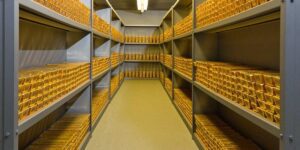
World central banks in July, according to preliminary estimates of the World Gold Council (WGC), increased the amount of gold in their gold reserves by 37.1 tons.
The largest buyers were Poland (14.3 tons), Uzbekistan (9.6 tons) and India (5.4 tons). Jordan (4.3 tons), Turkey (3.8 tons), Qatar (2.3 tons), Czech Republic (1.6 tons), Egypt and Malta (0.1 tons each) also increased their reserves
Kazakhstan (3.9 tons) and Mongolia (0.7 tons) sold gold.
“Central banks have remained committed to hoarding gold in recent months. While the overall level of demand cooled slightly as the gold price continued to rise to new highs, it nevertheless remained positive,” WGC analyst Krishan Gopaul said in a review.

World central banks in January, according to preliminary estimates of the World Gold Council (WGC), purchased in gold and foreign exchange reserves of 39 tons of gold.
This is more than double the specified volumes of December (16.9 tons) and makes January the eighth consecutive month of growth, notes WGC analyst Krishan Gopaul in his review.
The largest buyers in January were again Turkey (11.8 tons) and China (10 tons). Also bought gold in reserves India (8.7 tons), Kazakhstan (6.2 tons), Jordan (3.1 tons), Czech Republic (1.7 tons) and others.
Significant sales were reported only by the Central Bank of Russia (3.1 tons, according to WGC). This repeats a trend since 2021, Gopaul notes: a decline in stocks of about 3 tons followed by replenishment. “We believe this activity is related to the country’s coinage program,” he explains.

In June, the world central banks returned to gold purchases and, according to preliminary estimates of the World Gold Council (WGC), purchased 55.4 tons of gold into the gold and foreign exchange reserves. For comparison: in May, according to revised data, there was an outflow of 26.6 tons.
In June, Turkey returned to purchases (increased its reserves by 11.4 tons), which supported the general trend. The largest buyer was China (21.2 tons), as well as Poland (13.7 tons), Uzbekistan (8.4 tons), Czech Republic (2.5 tons), Qatar (1.6 tons), etc. were buying gold for reserves.
Only Kazakhstan (3.2 tons) and Singapore (1 ton) turned out to be large net sellers.

World central banks, according to preliminary data, bought 19.6 tons of gold in gold reserves in August, follows from the data of the World Gold Council (WGC).
This is the fifth consecutive month of growth, although its pace is declining, said WGC analyst Krishan Gopaul.
Turkey, the biggest buyer of gold this year, added another 8.9 tons to its reserves. In total, since the beginning of the year, it has purchased 84 tons of gold and brought its volume in reserves to 478.2 tons.
Uzbekistan bought 8.7 tons of gold in August, from the beginning of the year – 19.3 tons, increasing reserves to 381.3 tons.
In third place in terms of purchases in August was Kazakhstan with 2 tons, although in total since the beginning of the year it has reduced the volume of gold in reserves by 27.6 tons, to 374.8 tons.
Gopaul notes that according to the Central Bank of Qatar, he also bought gold in August, but so far the exact figures have not been disclosed and therefore are not reflected in the WGC statistics.